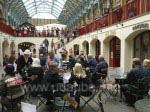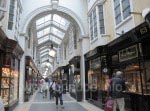|
|
Shopping in the World City London
Shopping in London is an experience that covers all areas. From the flea market up to the luxury department store, from a firm shop up to a sophisticated one, one finds the whole range of shopping possibilities; Names as Harrod's, Mark & Spencer or Picadilly with the oldest british retailers are famous worldwide. And who has never heard about Christie's or Sotheby's? These auction houses are simply institutions that oftenly cause worldwide attention by super auctions. A speciality of London are the department stores of which there are numerous ones spread allover the city and that are of the traditional allround assortment of goods, from food to drapery up to household articles and jewelry. London is a centre of designers who of course also offer here their fashion, as representation can be mentioned Stella Mc Cartney. Those who are looking for a real piece of design and have enough money for it will surely find it.But the opposite is also possible. At the main traffic road of London, there are countless shops that offer very nice fashion of good quality at very reasonable prices. Those who are in addition regularly there during the sales period have a good chance to get a real bargain. Of course, the tourist will look for something typical English. As it is the case everywhere, in London there is also a salmagundi from kitsch up to decent souvenirs. Tea, jam or other sweeties surely belong to the latter, but certainly one of the nice souvenirs of the museum shops do. Generally, it is possible to shop in London from Monday to Saturday from 09.00 a.m. up to 05.30 p.m., whereby many department stores or shops at the main shopping streets are opened until later. In the big shops it is also possible to shop on Saturdays for some hours. Department Store Harrod'sHarrod's apparently isthedepartment store of London, it simply is a worldwide famous address. It got some additional fame through Princess Diana and her affair with Dodi Fayed, the son of the ownwer of this department store. Due to their tragic death and the myths about it, Mohamed Al-Fayed and his department store increasingly made the headlines. But despite of these gossips, Harrod's is an institution of London and one of the biggest exclusive department stores of the world. Charles Henry Harrod founded the enterprise in the year 1834 and displaced it later on to its present location at the Brompton Road in the city district Kightsbridge. After a devastating fire, the house was rebuilt during the years around 1900 in the style of eclecticistism. Up to the year 2001, Harrod's was the official purveyor to the court but it lost this privilege. As told by some believable gossips, this is due to the reason that Mohamed Al-Fayed, who owns the department store since 1985, also made the Duke of Edinburgh responsible for the death of his son and Diana. 

The illumination of the cladding with approximately 12.000 light bulbs is also very famous. Harrod's is just the opposite of a cheap shopping possibility but still abounds with people. Almost everybody who is in London wants to be at least once in Harrod's and have purchased something there, even if it is just a small item; We were there in the afternoon and have been rejected at the entrance due to overcrowding. We got in through a side entrance and where then pushed through the halls. But here, there are also some differences, as specially in the food department in the ground floor, that is arranged in art nouveau, the crowds are pushing. In the jewelry department to the contrry, it is very calmed, only well-heeled people get lost here. What is also interesting is to watch the women wearing burkas and trying different perfumes. If one stands for a time in front of the department store, one can watch the upper class of London arriving in their limousines. By the way, everybody is free to visit Harrod's, no matter of one's financial situation. But anyway, there are still some limitations considered. The security staff makes sure that rucksacks are carried with the hand and not at one's back. People who are noticeably dressed as for example punks or heavy metal fans are rejected. It is also hard for groups of youngsters to get in. Covent GardenCovent Garden, this term generaly stnds for the market halls of London. This is true but not completely right, as Covent Garden is a complete city district in the centre of London that looks back to a vivid history. The origin was a medieval convent garden that was covered with buildings from the year 1631. From these buildings of the beginning, only St. Paul's Church is remaining. 
In the late years of the 17th century, the flower and vegetables market of London moved here. But in the course of the time, the area increasingly developed to an amusement district with pool halls, bars and brothels. Then, the city fathers of London put the brakes on and in the year 1832, they ordered to clean the area and to arrange some market halls, the Central Hall. There, in front of the halls, also was the first encounter between Eliza Doolittle and Professor Higgins in G.B. Shaws "Pygmalion", also known as the musical "My fair Lady". This market existed up to the year 1974, which vivid activity was impressively documented in Hitchcocks movie "Frenzy". From that time, the market had been displaced and numerous merchants settled in small shops in the halls, coffee bars were arranged and also different stands offer goods. There is also a lot of culture, no matter if street arts or cabaret in the ground floor of the halls, there is something for all tastes. In the Jubilee Hall, there are different markets, an antique market on Mondays, a hand crafts market in the weekends and general market during the week. At the northern side of the plz with the halls there is the Royal Opera House, from which terrace it is possible to have a nice view over London. The London Transport Museum that shows the history of the mass passenger transport, is locted at the east side of the plaza. Smithfield MarketThe market halls of Smithfield Market are worth to visit but at an unearthly hour. It is one of the biggest meat markets of the world and additionally a very old one. In the bautiful halls made of iron and glass in Victorian style that were opened in the year 1866, there are despite of meat also different other delicacies as for example an abundant choice of cheese. Approximately 1300 tons of meat are handled here every day, an impressive figure. 

Those who want to experience this have the opportunity from 4.30 a.m. to 09.00 a.m., after that it is quiet there; Adopted to these times, the pubs of this area have a special permission to serve from 06.30 a.m. In order that getting up so early in the morning is worthwhile, one can continue from Smithfield Market to more explorations. In the immediate vicinity of the market there is the St. Paul's Cathedral, the Museum of London and the Millennium Bridge. The Holborn Viaduct is also worth to look at, it is a Victorian road bridge built from 1863 to 1869. The best way to get to the Smithfield Market is by subway to the stations Farringdon or Barbican. Portobello Road MarketPortobello Road Market is one of the most popular markets of London with a tradition of 150 years. Today, it is specially preferred by tourists. On Saturdays it is the most lively. One can practically get everything there, starting from rummage to valued antiques to clothes, CDs, jewelry up to fruits and vegetables. Those who are looking for antiques should arrive soon, but as a tourist one will rather not look for that. For this kind of visitors, the turbulence and little souvenirs are more important. A part of the market is specially popular that is located underneath the motorway bridge of Portobello Road and Ladbroke Grove. The salmagundi of kitsch, real arts and also old and new clothes is very attractive to tourists. At the crossover to Golborne Road the character of a flea market is definitely reached. During the week there it is less vivid, then the offer is limited to fruits and vegetables. Many will also remind the movie "Notting Hill" that was filmed here. Therewith it is also said that the market is located in the city district Notting Hill, thus out of the centre of London. Hays Galleria
Hay's Galleria is located right at the south bank of the Thames between the Tower Bridge and the London Bridge. If one arrives with the subway, it is recomendable to go up to the station London Bridge. A walk on the Queens's Walk alongside the water is very attractive and also passes the shopping centre. Hay's Galleria is a glass-roofed passage is located at the renovated and updated warehouses of Hay's Wharf. These former warehouses were sophisticately restaurated and present the bright sides of warehouse arquitecture. In the passage, there is a range of small shops and also cofee bars. It is a nice place to go specially when the weather is bad.In the interior of the passage there is an impressive sculpture to admire, "The Navigators". Burlington ArcadeAmidst the pulsing London, right at Picadily Circus, the Burlington Arcade branches off. This passage arrenged in regency style represents the elegant and posh London par excellence. In the year 1819, Lord Cavendish built this stylish and exclusive shopping street. By having a look into the shop windows, one knows that here, well-heeled people are required and that not any kind of customers will be received with open arms. 

Today, there are about 70 shops in the passage in which only gets the very finest. Those who are looking for a taylored shirt, a cashmere jumper or want to have some shoes specially made, are right here. The passage is always highly frequented, but the fewest will really do some shopping here. But there is for sure enough to look and to gaze at. The own guards who elegantly patrol in smoking and stovepipe hat also make understand that one is actualy in a posh milieu. The directions for the use of the passage, in which it is mentioned: "... a piazza for selling items that do not scandalise by their appearance nor by their odour" are highly interesting. Neither it is permitted to whistle nor to sing or to play an intrument, to carry a package or to open an umbrella; Even if this sounds a little overstretched in some points, sometimes one wishes some certain German shopping passages would have such tidiness. 
Author: Michael Nitzschke, Copyright: Patrick Wagner, www.tourist-guide.biz |
||